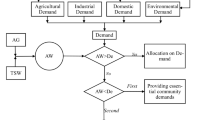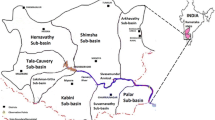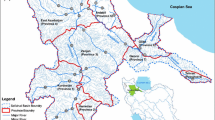Abstract
Water supply systems in watershed cities face challenges due to increasing water demand and arbitrary sewage discharge allocations. Previous studies have primarily focused on water resource allocation and sewage discharge rights, neglecting the intricate interactions between the two. This study introduces a novel approach by integrating sewage discharge rights into the watershed’s water resource allocation mechanism. A multi-objective optimization model was developed, employing the Gini coefficient to balance the equitable and economic aspects across various water sectors. This model takes into account the distinct water demands and sewage discharge requirements of different sectors. The findings of this study are as follows: (a) the Gini coefficients for water demand allocation and sewage discharge rights allocation exhibit simultaneous optimization and display consistent trends; (b) when the importance of sewage discharge relative to other water users increases, the return on investment for domestic and industrial water use decreases, but the fairness of water distribution improves; (c) proper allocation of sewage discharge rights can effectively enhance the economic value of agricultural water use. Overall, this strategy has the potential to enhance both the equality and economic benefits of the water supply system while ensuring the sustainable utilization of water and sewage rights in the basin cities.













Similar content being viewed by others
Data availability
The data that has been used is open.
References
Arya FK, Zhang L (2015) Time series analysis of water quality parameters at Stillaguamish River using order series method. Stochastic Stoch Environ Res Risk Assess 29(1):227–239. https://doi.org/10.1007/s00477-014-0907-2
Cao Y, Wan N, Zhang H, Zhang X, Zhou Q (2020) Linking environmental regulation and economic growth through technological innovation and resource consumption: analysis of spatial interaction patterns of urban agglomerations. Ecol Indic 112:106062. https://doi.org/10.1016/j.ecolind.2019.106062
Canter LW, Chawla MK, Swor CT (2014) Addressing trend-related changes within cumulative effects studies in water resources planning. Environ Impact Assess Rev 44:58–66. https://doi.org/10.1016/j.eiar.2013.07.004
Chandra S, Sarkhel M, Vatsa AK (2021) Capacitated facility location–allocation problem for wastewater treatment in an industrial cluster. Comput Oper Res 132(1):105338. https://doi.org/10.1016/j.cor.2021.105338
Chang SH, Li AQ, Wang X, Wang XY (2022) Joint optimization of e-commerce supply chain financing strategy and channel contract. Eur J Oper Res 303:908–927. https://doi.org/10.1016/j.ejor.2022.03.013
Cullis J, Koppen BV (2009) Applying the Gini coefficient to measure inequality of water use in the Olifants River Water Management Area. Iwmi Research Reports, South Africa. https://doi.org/10.3910/2009.113
Dadmand F, Naji-Azimi Z, Farimani NM et al (2020) Sustainable allocation of water resources in water-scarcity conditions using robust fuzzy stochastic programming. J Clean Prod 123812. https://doi.org/10.1016/j.jclepro.2020.123812
Dai D, Sun MD, Lv XB, Lei K (2020) Evaluating water resource sustainability from the perspective of water resource carrying capacity, a case study of the Yongding River watershed in Beijing-Tianjin-Hebei region, China. Environ Sci Pollut Res 27(17):21590–21603. https://doi.org/10.1007/s11356-020-08259-5
Daughton CG (2017) Monitoring wastewater for assessing community health: wastewater emission chemical-information mining (SCIM). Sci Total Environ 619:748–764. https://doi.org/10.1016/j.scitotenv.2017.11.102
Delorit JD, Block PJ (2019) Using seasonal forecasts to inform water market-scale option contracts. J Water Resour Plan Manage -ASCE 145(5). https://doi.org/10.1061/(ASCE)WR.1943-5452.0001068
Elbakidze L, Vinson H, Cobourn K et al (2018) Efficient groundwater allocation and binding hydrologic externalities. Resour Energy Econ 53:147–161. https://doi.org/10.1016/j.reseneeco.2018.05.002
Friesen J, Sinobas LR, Foglia L et al (2017) Environmental and socio-economic methodologies and solutions towards integrated water resources management. Sci Total Environ 581:906–908. https://doi.org/10.1016/j.scitotenv.2016.12.051
Gong ML, Yuan Q, Liu L (2022) How local industries respond to the discharge permit regulation: an agent-based modelling approach. Resour. Conserv. Recycl. 182:106280. https://doi.org/10.1016/J.RESCONREC.2022.106280
Guo P, Huang GH, Zhu H et al (2010) A two-stage programming approach for water resources management under randomness and fuzziness. Environ Modell Softw 25(12):1573–1581. https://doi.org/10.1016/j.envsoft.2010.04.018
Hu Z, Chen Y, Yao L et al (2016) Optimal allocation of regional water resources: from a perspective of equity–efficiency tradeoff. Resour Conserv Recycl 109:102–113. https://doi.org/10.1016/j.resconrec.2016.02.001
Hou J, Ye A, You J et al (2018) An estimate of human and natural contributions to changes in water resources in the upper reaches of the Minjiang River. Sci Total Environ 635:901–912. https://doi.org/10.1016/j.scitotenv.2018.04.163
Konishi Y, Coggins JS, Wang B (2015) Water-quality trading: can we get the prices of pollution, right? Wat Resources Res 51(5):3126–3144. https://doi.org/10.1002/2014wr015560
Kroll C, Warchold A, Pradhan P (2019) Sustainable development goals (SDGs): are we successful in turning trade-offs into synergies? Palgr Commun 5(1). https://doi.org/10.1057/s41599-019-0335-5
Lekakis G (1997) Policy analysis for an amicable, efficient and sustainable inter-country fresh water resource allocation. Ecol Econ 21(3):231–242. https://doi.org/10.1016/s0921-8009(96)00109-7
Li JY, Cui LB, Dou M et al (2021) Water resources allocation model based on ecological priority in the arid region. Environ Res 199:111201. https://doi.org/10.1016/j.envres.2021.111201
Liu DH, Ji XX, Tang JF, Li HY (2020a) A fuzzy cooperative game theoretic approach for multinational water resource spatiotemporal allocation. Eur J Oper Res 282(3):1025–1037. https://doi.org/10.1016/j.ejor.2019.10.018
Liu Y, Yang L, Jiang W (2020b) Coupling coordination and spatiotemporal dynamic evolution between social economy and water environmental quality-a case study from Nansi Lake catchment, China. Ecol Indic 119:106870. https://doi.org/10.1016/j.ecolind.2020.106870
Liu Y, Zhang Z, Huang X (2023) A novel coupling cloud decision-making framework for investigating population-economy-water consumption nexus in the Inner Mongolia reaches of the Yellow River, China. Environ Impact Assess Rev 98:106923. https://doi.org/10.1016/j.eiar.2022.106923
Mo L, Ping G (2014) A multi-objective optimal allocation model for irrigation water resources under multiple uncertainties. Appl Math Model 38(19-20):4897–4911. https://doi.org/10.1016/j.apm.2014.03.043
Mooselu MG, Nikoo MR, Latifi M et al (2020) A multi-objective optimal allocation of treated wastewater in urban areas using leader-follower game. J Clean Prod 267:122189. https://doi.org/10.1016/j.jclepro.2020.122189
MRB (2019) Minjiang River Basin Water Resources Bulletin 2019. http://slt.sc.gov.cn/scsslt/szyzwgk/2022/11/30/19961ab0518840a98c8d52b7163505a4.shtml
Murray A, Ray I (2010) Wastewater for agriculture: a reuse-oriented planning model and its application in peri-urban China. Water Res 44(5):1667–1679. https://doi.org/10.1016/j.watres.2009.11.028
Nabi G, Ali M, Khan S et al (2019) The crisis of water shortage and pollution in Pakistan: risk to public health, biodiversity, and ecosystem. Environ Sci Pollut Res 26(11):10443–10445. https://doi.org/10.1007/s11356-019-04483-w
Nasiri-Gheidari O, Marofi S, Adabi F (2018) A robust multi-objective bargaining methodology for inter-basin water resource allocation: a case study. Environ Sci Pollut Res 25(3):2726–2737. https://doi.org/10.1007/s11356-017-0527-8
Peng YT, Wang W, Li SL, Eleonora V (2022) Competition and cooperation in the dual-channel green supply chain with customer satisfaction. Econ Anal Policy 76:95–113
Pourmand E, Mahjouri N, Hosseini M et al (2020) A multi-criteria group decision making methodology using interval type-2 fuzzy sets: application to water resources management. Water Res Manage 34(13):4067–4092. https://doi.org/10.1007/s11269-020-02657-7
Shen X, Wu X, Xie X et al (2021) Synergetic theory-based water resource allocation model. Water Res Manage 35(7):2053–2078. https://doi.org/10.1007/s11269-021-02766-x
Siciliano G, Urban F (2017) Equity-based natural resource allocation for infrastructure development: evidence from large hydropower dams in Africa and Asia. Ecol Econ 134:130–139. https://doi.org/10.1016/j.ecolecon.2016.12.034
Soller JA et al (2018) Direct potable reuse microbial risk assessment methodology: sensitivity analysis and application to state log credit allocations. Water Res 128:286–292. https://doi.org/10.1016/j.watres.2017.10.034
Song WZ, Yuan Y, Jiang YZ et al (2016) Rule-based water resource allocation in the Central Guizhou Province, China. Ecol Eng 87:194–202. https://doi.org/10.1016/j.ecoleng.2015.11.051
Sun T, Zhang H, Wang Y et al (2010) The application of environmental Gini coefficient (EGC) in allocating wastewater discharge permit: the case study of watershed total mass control in Tianjin, China. Resour Conserv Recycl 54(9):601–608. https://doi.org/10.1016/j.resconrec.2009.10.017
Tu Y, Zhou XY, Gang J et al (2015) Administrative and market-based allocation mechanism for regional water resources planning. Resour Conserv Recycl 95:156–173. https://doi.org/10.1016/j.resconrec.2014.12.011
Wang T, Liu Y, Wang Y et al (2019) A multi-objective and equilibrium scheduling model based on water resources macro allocation scheme. Wat Res Manage 33(10):3355–3375. https://doi.org/10.1007/s11269-019-02304-w
Xie YL, Huang GH, Li W et al (2013) An inexact two-stage stochastic programming model for water resources management in Nansihu Lake Basin, China. J Environ Manage 127:188–205. https://doi.org/10.1016/j.jenvman.2013.04.027
Xie QW, Xu QF, Rao KF, Dai QZ (2022) Water pollutant discharge permit allocation based on DEA and non-cooperative game theory. J Environ Manage 302(A):113962. https://doi.org/10.1016/j.jenvman.2021.113962
Xu J, Ni J, Zhang M (2015) Constructed wetland planning-based bilevel optimization model under fuzzy random environment: case study of Chaohu Lake. J Water Resour Plan Manage-ASCE 141:3. https://doi.org/10.1061/(asce)wr.1943-5452.0000440
Xu Y, Wang Y, Li S et al (2017) Stochastic optimization model for water allocation on a watershed scale considering wetland’s ecological water requirement. Ecol Indic 92:330–341. https://doi.org/10.1016/j.ecolind.2017.02.019
Xu ZW, Yao LM, Zhang Q et al (2020) Inequality of water allocation and policy response considering virtual water trade: A case study of Lanzhou city, China. J Clean Prod 269:122326. https://doi.org/10.1016/j.jclepro.2020.122326
Yao L, He L, Chen X (2020) Trade-off between equity and efficiency for allocating wastewater emission permits in watersheds considering transaction. J Environ Manage 270:110898. https://doi.org/10.1016/j.jenvman.2020.110898
Yazdi J, Moridi A (2017) A optimal allocation of flood control capacity for multi-reservoir systems using multi-objective optimization approach. Water Resour Manag 31(14):4521–4538. https://doi.org/10.1007/s11269-017-1763-x
Yuan MK, Chen XD, Liu GZ et al (2022) Coordinated allocation of water resources and wastewater emission permits based on multi-objective optimization model: from the perspective of conflict between equity and economic benefits. J Clean Prod 372:133733. https://doi.org/10.1016/j.jclepro.2022.133733
Yzac D, Lcc B, Tsu A et al (2019) Prospect for small-hydropower installation settled upon optimal water allocation: an action to stimulate synergies of water-food-energy nexus. Appl Energy 23:668–682. https://doi.org/10.1016/j.apenergy.2019.01.069
Zhang H, Ha M, Zhao H et al (2017) Inexact multistage stochastic chance constrained programming model for water resources management under uncertainties. Sci Program 2017:1680813. https://doi.org/10.1155/2017/1680813
Zhang JL, Li YP, Zeng XT et al (2018) Effluent trading planning and its application in water quality management: a factor-interaction perspective. Environ Res 168:286–305. https://doi.org/10.1016/j.envres.2018.09.029
Zhang Y, Liu W, Cai Y, Khan SU, Zhao M (2021) Decoupling analysis of water use and economic development in arid region of China – based on quantity and quality of water use. Sci Total Environ 761:143275. https://doi.org/10.1016/j.scitotenv.2020.143275
Zhu FL, Zhong PA, Cao Q et al (2019) A stochastic multi-criteria decision-making framework for robust water resources management under uncertainty. J Hydrol 576:287–298. https://doi.org/10.1016/j.jhydrol.2019.06.049
Zhang Z, Li Y, Wang X et al (2022) Investigating river health and potential risks using a novel hybrid decision-making framework with multi-source data fusion in the Qinghai-Tibet Plateau. Environ Impact Assess Rev 96:106849. https://doi.org/10.1016/j.eiar.2022.106849
Funding
This work was supported by the Chengdu University of Technology Postgraduate Research Program for Innovative and Top-notch Talents (Grant No. CDUT2022BJCX012).
Author information
Authors and Affiliations
Contributions
Mingkang Yuan: conceptualization, methodology, validation, writing—original draft. Xudong Chen: software, validation, data curation, review original draft. Yue Li: data curation, supervision, writing—review and editing. Zixuan Zhang: software, validation, data curation. Lin Wang: data collection and processing, editing and typesetting.
Corresponding author
Ethics declarations
Ethical approval
Not applicable.
Consent to participate
Not applicable.
Consent for publication
Not applicable.
Competing interests
The authors declare no competing interests.
Additional information
Responsible Editor: Philippe Garrigues
Publisher’s note
Springer Nature remains neutral with regard to jurisdictional claims in published maps and institutional affiliations.
Highlights
•Innovative integration of sewage discharge rights into watershed water management.
•A multi-objective model was developed to optimize the urban water supply system.
•A model that considers equity, economics, and the environment can improve sustainable water use.
Rights and permissions
Springer Nature or its licensor (e.g. a society or other partner) holds exclusive rights to this article under a publishing agreement with the author(s) or other rightsholder(s); author self-archiving of the accepted manuscript version of this article is solely governed by the terms of such publishing agreement and applicable law.
About this article
Cite this article
Yuan, ., Chen, X., Li, Y. et al. Collaborative optimal allocation of water resources and sewage discharge rights in watershed cities: considering equity among water sectors. Environ Sci Pollut Res 30, 88949–88967 (2023). https://doi.org/10.1007/s11356-023-28664-w
Received:
Accepted:
Published:
Issue Date:
DOI: https://doi.org/10.1007/s11356-023-28664-w




